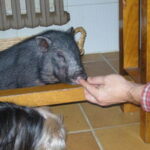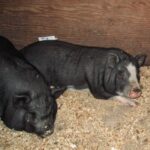In the 1980’s Vietnamese potbellied pigs were introduced into the United States from Canada. This started a new craze and breeders began appearing everywhere offering these pigs as pets. Vietnamese potbellied pigs are very intelligent creatures and can make excellent pets provided owners are prepared to care for their special needs.
Considerations for Pet Owners
Early pet breeders left pet owners with the impression that their pot bellied pigs would stay little and cute. This is not the case. A full-grown potbellied pig can as much as weigh 150 lb. and sometimes reach a weight of 200 lb. Feeding them less does not make them stay small and underfeeding can be very dangerous to the pig’s health. These pigs love to root and if not controlled can turn a well-manicured lawn into a disaster. Pigs do not like to be held as they are prey by nature and picking them up can alarm them. Vietnamese potbellied pigs will display aggressive behaviors if not neutered or spayed. Dogs and potbellied pigs are a bad combination. Dogs have been known to attack and injure potbellied pigs. Hundreds of potbellied pigs are abandoned every year because their owners are not fully prepared to care for them as pets. Life expectancy is 12-15 years so having a potbellied pig as a pet is a lifetime commitment. Consider the special needs of Vietnamese potbellied pigs before making the decision to have one as a pet.
Physical Characteristics
Vietnamese potbellied pigs are a miniature breed of swine and full-grown pigs averaging in size from 70-150 lb., 3-ft. long and 15-inches tall. Originally, colors were solid black or white with spots in between. Creative breeding efforts have produced varieties of white, tan, red and silver colors. All varieties have characteristically short legs, straight tails and a large potbelly, thus the name. Their hair is firm and prickly and the skin can sometimes be dry and flaky.
Traits of Potbellied Pigs
Potbellied pigs are generally good- natured. They love to root. It may be a good idea to provide a rooting box filled with sand and stones large enough not to be swallowed. Contrary to popular belief, pigs are very clean animals and enjoy cooling off in a pool filled with cool water. Vietnamese potbellied pigs are very smart and can taught to perform a variety of tricks including sitting and fetching.
Potbellied Pig Diet
Your pot-bellied pig requires a special diet. In the wild, natural foods would be roots, plants, insects, and a variety of other natural foods. For proper nutrition, you should consult your veterinarian for a specialized feed for potbellied pigs. There are varieties of starter, grower and maintenance diets. The nutritional needs for Vietnamese potbellied pigs are different from that of commercial pigs. Fruit treats can be offered occasionally and used as rewards in training. Potbellied pigs have a tendency to become overweight so do not over feed them.
Caring for your Pet
If your pet will be staying outside, make sure he has a warm, dry and sheltered area such as a doghouse. Provide plenty of blankets and straw. Vietnamese potbellied pigs are most comfortable at a temperature around 70 degrees. Pigs are sensitive to extreme hot or cold and are unable to sweat. Sunscreen should be used to prevent sunburn. They will need a place to cool off from the heat such as a child’s swimming pool. Indoor pets will need adequate space to move around with a litter area. Litter areas should not be next to the feeding area. A large tub will work well lined with newspapers and pine chips. Annual vaccinations are required. Hooves should be trimmed at least once a year. Males should be neutered before they are 3 months of age and females may be spayed as early of 6 weeks old.
Sources:
http://www.bellydraggersranch.com/pig_information.html
http://www.petpigs.com/brochures/11.%20The%20Vet%20and%20Your%20Pig.pdf




